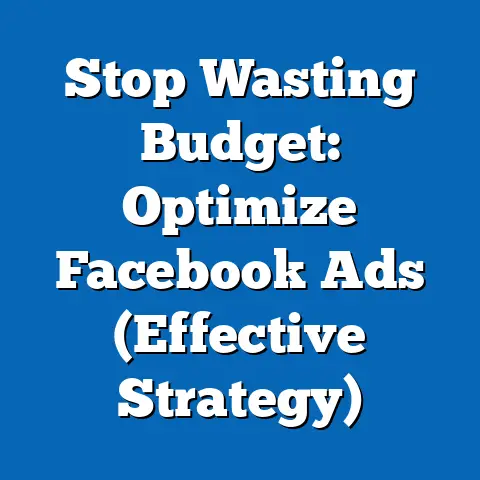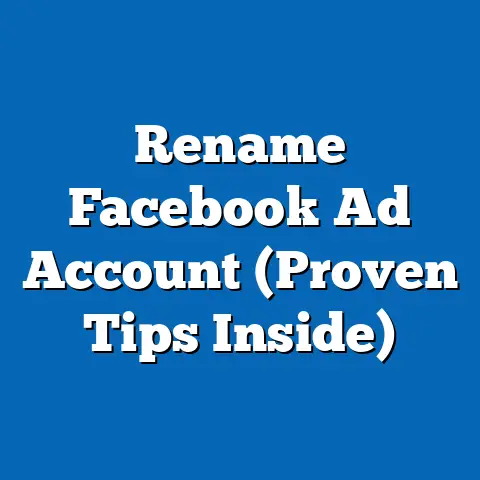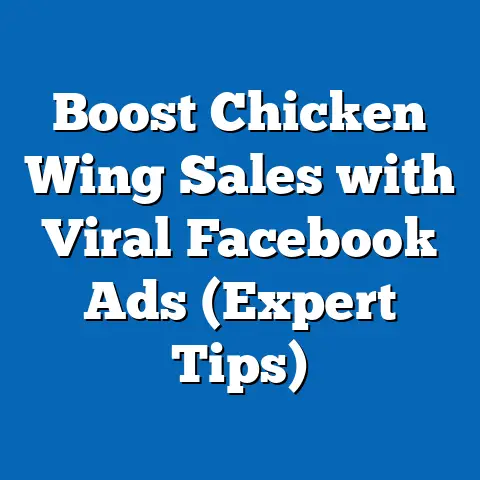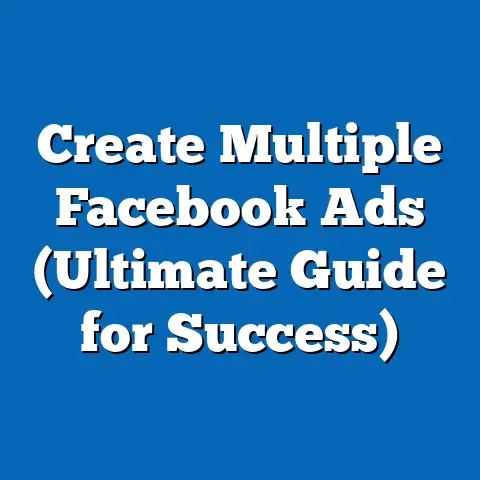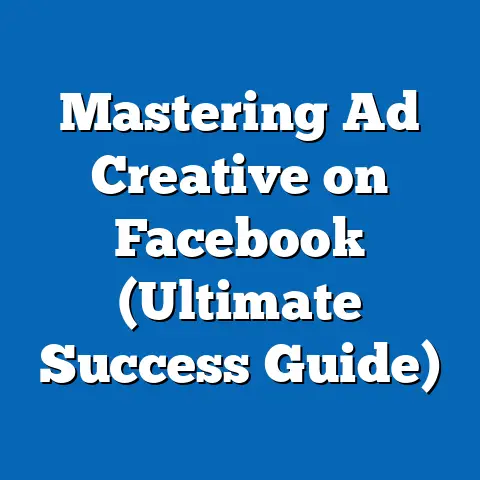Unlock Facebook Carousel Ads Success (Proven Strategies)
Facebook Carousel Ads. They’re not just another ad format; they’re a dynamic, engaging way to tell your brand’s story, showcase a range of products, or highlight multiple features – all within a single ad unit. I remember when I first started using them, I was blown away by how much more engaging they were compared to single-image ads. The ability to swipe, explore, and essentially “browse” within an ad felt like a game-changer.
Whether you’re an e-commerce store, a travel agency, or a real estate firm, Carousel Ads offer unparalleled flexibility to cater to your audience’s unique preferences and behaviors. I’ve seen businesses completely transform their Facebook ad performance by strategically leveraging this format. In this guide, I’ll walk you through proven strategies to unlock the full potential of Facebook Carousel Ads and drive real results for your business. Get ready to dive deep into the world of visual storytelling and interactive marketing!
What are Facebook Carousel Ads?
Let’s start with the basics. Facebook Carousel Ads are an ad format that allows you to showcase multiple images or videos (up to 10) within a single ad. Users can swipe through these cards, each with its own headline, description, link, and call-to-action. Think of it as a mini-website right within the Facebook News Feed.
I like to think of them as the “choose your own adventure” of Facebook ads. They offer a level of interactivity that traditional single-image ads simply can’t match.
Why Choose Carousel Ads?
The benefits of using Carousel Ads are numerous:
- Increased Engagement: The swipeable format naturally encourages users to interact with your ad. People are more likely to spend time exploring multiple images or videos than passively scrolling past a static ad.
- Storytelling Potential: Carousel Ads allow you to tell a complete story or guide users through a journey. You can showcase different product features, highlight customer testimonials, or even create a step-by-step guide.
- Showcase Multiple Products: E-commerce businesses can display a range of products within a single ad, increasing the chances of capturing a user’s interest.
- Improved Click-Through Rates: Because they are more engaging, Carousel Ads often see higher click-through rates (CTR) than single-image ads.
- Versatility: They work for almost any industry! I’ve seen them succeed in retail, travel, real estate, automotive, and even B2B.
Stats Don’t Lie
Don’t just take my word for it. Studies have shown that Carousel Ads can generate up to 10x more traffic than static social media ads. I’ve personally seen clients achieve a 72% higher click-through rate using Carousel Ads compared to single-image ads. These numbers speak for themselves.
Takeaway: Carousel Ads are a powerful and versatile ad format that can significantly boost engagement, traffic, and conversions. If you’re not already using them, you’re missing out! Next step: let’s dive into understanding your target audience.
Understanding Your Target Audience
Before you even think about creating a Carousel Ad, you need to deeply understand your target audience. I always tell my clients: “You’re not selling to everyone; you’re selling to someone.” And that “someone” needs to be clearly defined.
Why Audience Analysis is Crucial
Crafting effective Carousel Ads requires a solid understanding of your audience’s demographics, interests, behaviors, and pain points. What motivates them? What are their aspirations? What problems are they trying to solve?
Without this knowledge, your ads will fall flat. You’ll be showing the wrong message to the wrong people, and your budget will quickly disappear.
Gathering Audience Insights
Here are some tools and methods for gathering valuable audience insights:
- Facebook Audience Insights: This free tool (though its functionality has been somewhat limited in recent years) provides a wealth of data about Facebook users. You can explore demographics, interests, behaviors, page likes, and more.
- Facebook Pixel: Install the Facebook Pixel on your website to track user actions, such as page views, add-to-carts, and purchases. This data helps you understand how users interact with your website and which segments are most valuable.
- Google Analytics: Use Google Analytics to analyze website traffic and identify key audience segments. You can track demographics, interests, and behavior patterns.
- Customer Surveys: Directly ask your customers about their preferences, needs, and pain points. Use online survey tools like SurveyMonkey or Google Forms.
- Competitor Analysis: Analyze your competitors’ Facebook pages and ads to see what resonates with their audience. Pay attention to the comments, shares, and reactions.
Customer Personas: The Key to Room-Specific Needs
Once you’ve gathered enough data, it’s time to create customer personas. These are fictional representations of your ideal customers, based on research and data. A well-defined persona includes demographics, interests, motivations, pain points, and buying behaviors.
For example, if you’re selling travel packages, you might create personas like “The Adventure Seeker,” “The Luxury Traveler,” and “The Budget Backpacker.” Each persona has different needs and preferences, and your Carousel Ads should be tailored accordingly.
Takeaway: Deeply understanding your target audience is essential for creating effective Carousel Ads. Use a combination of data analysis, customer surveys, and competitor research to develop detailed customer personas. Next, we’ll explore how to craft compelling visual content.
Crafting Compelling Visual Content
In the visually-driven world of social media, high-quality visuals are paramount. I’ve always believed that your images are the first handshake with a potential customer. If they’re blurry, unappealing, or irrelevant, you’ve already lost the battle.
The Power of Visuals
Your Carousel Ads should feature visually stunning images or videos that instantly capture attention and resonate with your target audience. Think about what makes your audience tick. What kind of aesthetic do they appreciate? What emotions do you want to evoke?
Tips for Creating Appealing Visuals
- Use High-Resolution Images: Avoid blurry or pixelated images. Use high-resolution images that look crisp and professional.
- Optimize for Mobile: Most Facebook users access the platform on their mobile devices. Make sure your visuals look great on smaller screens.
- Tell a Story: Use your visuals to tell a story or highlight a key benefit. Show the transformation that your product or service can provide.
- Showcase Your Product in Action: Instead of just showing a static product image, show it being used in a real-world setting.
- Use Videos: Videos are incredibly engaging and can capture attention more effectively than static images. Consider using short, attention-grabbing videos in your Carousel Ads.
- Keep it Consistent: Maintain a consistent visual style across all your carousel cards. Use similar colors, fonts, and branding elements.
Branding Matters
Your Carousel Ads should be consistent with your overall brand identity. Use your brand colors, logos, and fonts to create a cohesive look and feel. This helps to reinforce brand recognition and build trust with your audience.
Balancing Visuals with Text
While visuals are important, don’t forget about the text! Each carousel card should include a concise and compelling headline and description. The text should complement the visuals and provide additional information about the product or service being showcased.
Takeaway: Compelling visuals are essential for capturing attention and driving engagement with your Carousel Ads. Use high-quality images and videos that resonate with your target audience and maintain a consistent brand identity. Next up, we’ll explore the art of writing effective copy.
Writing Effective Copy
Visuals might grab attention, but it’s the copy that seals the deal. I always say, “Your copy is your sales pitch in written form.” It needs to be persuasive, informative, and tailored to your target audience.
The Importance of Concise Copy
In the fast-paced world of social media, people have short attention spans. Your copy needs to be concise, clear, and to the point. Avoid jargon and focus on the key benefits of your product or service.
Headlines that Hook
Your headlines are the first thing people will see. They need to be attention-grabbing and compelling. Use strong verbs, numbers, and keywords to make your headlines stand out.
Here are some headline examples:
- “5 Ways to [Solve a Problem]”
- “The Ultimate Guide to [Achieving a Goal]”
- “Get [Desired Result] in [Timeframe]”
- “Discover the Secret to [Achieving a Result]”
- “Limited-Time Offer: [Discount or Benefit]”
Descriptions that Persuade
Your descriptions should provide additional information about the product or service being showcased. Highlight the key benefits and features, and explain how it can solve a problem or fulfill a need.
Use persuasive language and include social proof, such as testimonials or reviews.
The Power of a Strong Call-to-Action (CTA)
Every carousel card should include a clear and compelling call-to-action (CTA). What do you want users to do? Visit your website? Make a purchase? Sign up for a newsletter?
Use action-oriented language and make your CTAs prominent and easy to click.
Here are some effective CTA examples:
- “Shop Now”
- “Learn More”
- “Sign Up Today”
- “Get Started”
- “Download Now”
Aligning Copy with Room-Specific Needs
Remember, your copy needs to be tailored to the specific needs and preferences of your target audience. Use language that resonates with them and addresses their pain points.
Takeaway: Concise, persuasive copy is essential for driving clicks and conversions with your Carousel Ads. Use strong headlines, compelling descriptions, and clear calls-to-action. Next, we’ll explore how to strategically structure your carousel.
Strategically Structuring Your Carousel
The order in which you present your carousel cards can have a significant impact on engagement and conversions. I like to think of it as crafting a mini-narrative. How do you want to guide your audience through your story?
Telling a Cohesive Story
Your carousel should tell a cohesive story or guide users through a journey. Think about the overall message you want to convey and structure your cards accordingly.
Here are some different structures you can use:
- Product Features: Showcase different features of a product or service, highlighting the benefits of each.
- Customer Testimonials: Feature customer testimonials or reviews to build trust and credibility.
- Step-by-Step Guide: Provide a step-by-step guide on how to use your product or service.
- Problem/Solution: Highlight a problem that your target audience faces and then present your product or service as the solution.
- Before/After: Show the transformation that your product or service can provide.
The Importance of Sequence
The sequence of your images or videos is crucial for maintaining user engagement. Start with your most compelling visual and save the best for last.
Optimal Number of Cards
While you can use up to 10 cards in your Carousel Ads, that doesn’t necessarily mean you should. I’ve found that 3-5 cards is often the sweet spot. Too few cards and you might not have enough information. Too many cards and you risk overwhelming your audience.
Examples of Effective Carousel Structures
- E-commerce: Start with a visually appealing product image, followed by cards highlighting key features, customer testimonials, and a call-to-action to shop now.
- Travel: Showcase different destinations within a region, highlighting the unique attractions of each.
- Real Estate: Feature different rooms of a property, highlighting the key features and benefits of each.
Takeaway: Strategically structuring your carousel cards is essential for telling a cohesive story and guiding users through a journey. Experiment with different structures to see what resonates best with your audience. Next, we’ll explore how to test and optimize your Carousel Ads.
Testing and Optimizing Your Carousel Ads
Creating a great Carousel Ad is just the first step. The real magic happens when you start testing and optimizing your ads based on performance data. I always tell my clients, “Advertising is not a set-it-and-forget-it game. It’s an ongoing process of refinement.”
The Power of A/B Testing
A/B testing involves creating two or more versions of your ad and then comparing their performance to see which one performs better. You can test different elements such as visuals, copy, CTAs, and targeting options.
What to Test
Here are some elements you can test in your Carousel Ads:
- Visuals: Test different images and videos to see which ones resonate best with your audience.
- Headlines: Test different headlines to see which ones generate the most clicks.
- Descriptions: Test different descriptions to see which ones are most persuasive.
- CTAs: Test different calls-to-action to see which ones drive the most conversions.
- Targeting: Test different targeting options to see which audiences are most responsive.
Analyzing Performance Metrics
Keep a close eye on your performance metrics, such as:
- Click-Through Rate (CTR): The percentage of people who click on your ad.
- Engagement Rate: The percentage of people who interact with your ad (likes, comments, shares).
- Conversion Rate: The percentage of people who complete a desired action (e.g., purchase, sign-up).
- Cost Per Click (CPC): The amount you pay each time someone clicks on your ad.
- Cost Per Conversion (CPC): The amount you pay for each conversion.
Iterative Optimization
Ad optimization is an iterative process. Continuously monitor your performance metrics and make adjustments to your ads based on the data. Don’t be afraid to experiment and try new things.
Takeaway: Testing and optimizing your Carousel Ads is essential for maximizing your ROI. Use A/B testing to experiment with different elements and continuously monitor your performance metrics.
Conclusion
Facebook Carousel Ads offer a dynamic and engaging way to connect with your target audience and drive real results for your business. By understanding room-specific needs, crafting compelling visuals and copy, strategically structuring your carousel, and continuously testing and optimizing your ads, you can unlock the full potential of this powerful ad format. The key to success lies in a thoughtful, strategic approach tailored to the unique requirements of your target audience. So, go forth, experiment, and watch your Facebook ad performance soar!

